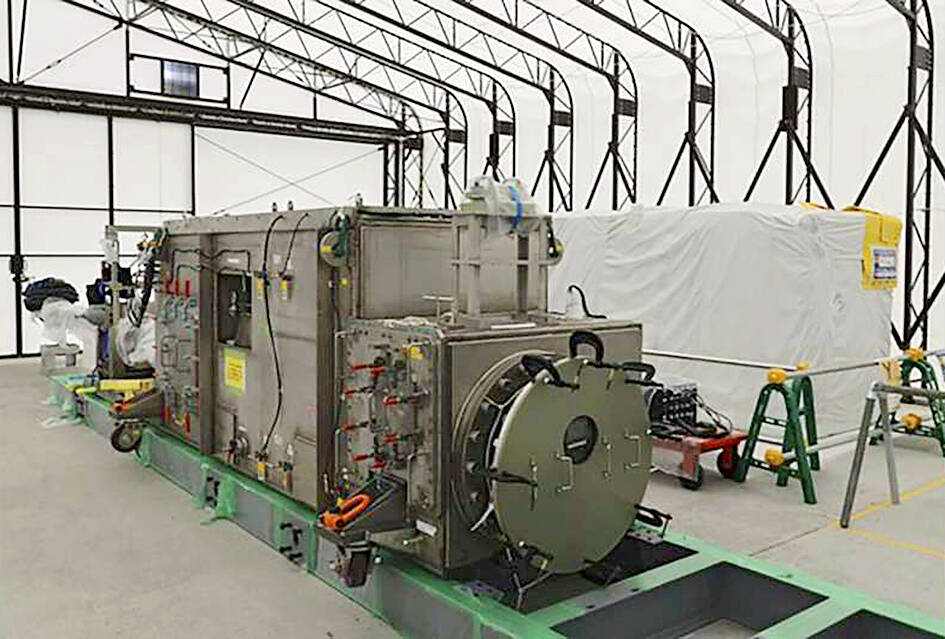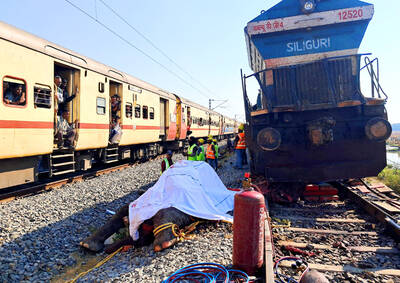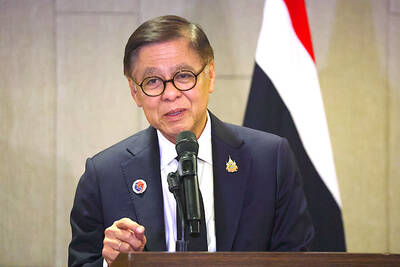An attempt to use an extendable robot to remove a fragment of melted fuel from a wrecked reactor at Japan’s tsunami-hit Fukushima Dai-ichi nuclear power plant was suspended yesterday due to a technical issue.
The collection of a tiny sample of the debris inside Unit 2 reactor’s primary containment vessel would start the fuel debris removal phase, the most challenging part of the decades-long decommissioning of the plant, at which three reactors were destroyed after a tsunami hit the site following an earthquake measuring 9.0 on the Richter scale on March 11, 2011.
The work was stopped when workers noticed that five 1.5m pipes used to maneuver the robot were placed in the wrong order and could not be corrected within the time limit for their radiation exposure, said Tokyo Electric Power Co Holdings (TEPCO), the plant’s operator.

Photo curtesy of TEPCO via AP
The pipes were to be used to push the robot inside and pull it back out when it finished. Once inside the vessel, the robot is operated remotely from a safer location.
The robot can extend up to about 22m to reach its target area to collect a fragment from the surface of the melted fuel mound using a device equipped with tongs that hang from the tip of the robot.
The mission to obtain the fragment and return with it is to last two weeks.
A new start date had not been decided, TEPCO said.
TEPCO president Tomoaki Kobayakawa said the priority was safety rather than rushing the process and that he planned to investigate the cause of the pipe setup problem.
“I understand that the decision was to stop and not push when there was a concern,” Kobayakawa told reporters in Niigata Prefecture, where he visited to discuss another TEPCO-operated nuclear power plant with the local community.
The sample-return mission is the first crucial step of a decades-long decommissioning at the Fukushima Dai-ichi site.
However, its goal to bring back less than 3g of an estimated 880 tonnes of radioactive molten fuel underscores the daunting challenges.
Despite the small amount of the debris sample, it would provide key data to develop decommissioning methods and necessary technology and robots, experts say.
Better understanding of the melted fuel debris is key to decommissioning the three wrecked reactors and the entire plant.
The Japanese government and TEPCO are sticking to a 30-to-40-year cleanup target set soon after the meltdown, despite criticism that it is unrealistic. No specific plans for the full removal of the melted fuel debris or its storage have been decided.

REVENGE: Trump said he had the support of the Syrian government for the strikes, which took place in response to an Islamic State attack on US soldiers last week The US launched large-scale airstrikes on more than 70 targets across Syria, the Pentagon said on Friday, fulfilling US President Donald Trump’s vow to strike back after the killing of two US soldiers. “This is not the beginning of a war — it is a declaration of vengeance,” US Secretary of Defense Pete Hegseth wrote on social media. “Today, we hunted and we killed our enemies. Lots of them. And we will continue.” The US Central Command said that fighter jets, attack helicopters and artillery targeted ISIS infrastructure and weapon sites. “All terrorists who are evil enough to attack Americans are hereby warned

‘POLITICAL LOYALTY’: The move breaks with decades of precedent among US administrations, which have tended to leave career ambassadors in their posts US President Donald Trump’s administration has ordered dozens of US ambassadors to step down, people familiar with the matter said, a precedent-breaking recall that would leave embassies abroad without US Senate-confirmed leadership. The envoys, career diplomats who were almost all named to their jobs under former US president Joe Biden, were told over the phone in the past few days they needed to depart in the next few weeks, the people said. They would not be fired, but finding new roles would be a challenge given that many are far along in their careers and opportunities for senior diplomats can

Seven wild Asiatic elephants were killed and a calf was injured when a high-speed passenger train collided with a herd crossing the tracks in India’s northeastern state of Assam early yesterday, local authorities said. The train driver spotted the herd of about 100 elephants and used the emergency brakes, but the train still hit some of the animals, Indian Railways spokesman Kapinjal Kishore Sharma told reporters. Five train coaches and the engine derailed following the impact, but there were no human casualties, Sharma said. Veterinarians carried out autopsies on the dead elephants, which were to be buried later in the day. The accident site

RUSHED: The US pushed for the October deal to be ready for a ceremony with Trump, but sometimes it takes time to create an agreement that can hold, a Thai official said Defense officials from Thailand and Cambodia are to meet tomorrow to discuss the possibility of resuming a ceasefire between the two countries, Thailand’s top diplomat said yesterday, as border fighting entered a third week. A ceasefire agreement in October was rushed to ensure it could be witnessed by US President Donald Trump and lacked sufficient details to ensure the deal to end the armed conflict would hold, Thai Minister of Foreign Affairs Sihasak Phuangketkeow said after an ASEAN foreign ministers’ meeting in Kuala Lumpur. The two countries agreed to hold talks using their General Border Committee, an established bilateral mechanism, with Thailand